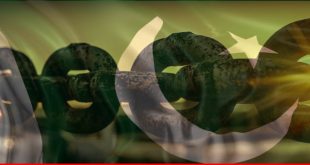Established following World War II to help with post-war recovery, the International Monetary Fund (IMF) serves as a lender to modern governments and an overseer of international financial markets.
Both the International Monetary Fund and the World Bank were created in 1944 at a conference in Bretton Woods, New Hampshire, and are now based in Washington, DC. The IMF was originally designed to promote international economic cooperation and provide its member countries with short term loans so they could trade with other countries.
The IMF now acts like a global loan shark, exerting enormous leverage over the economies of more than 60 countries including Pakistan. These countries have to follow the IMF’s policies to get loans, international assistance, and even debt relief. The IMF is one of the most powerful institutions on Earth — yet few know how it works. There are a lot of misconceptions for the IMF.
The IMF supporters claim that it is a necessary lender of last resort for countries in financial crisis and that it can impose necessary or difficult reforms on backward economies. Critics counter that the IMF supersedes national autonomy, exacerbates economic problems more often than not, and serves as a tool of the wealthiest nations only. Highlighted the IMF advantages, they saying the IMF assists member nations in several different capacities. If a country has a balance of payments deficit, the IMF can step in to fill the gap. It serves as a council and adviser to countries attempting a new economic policy. Its most important function is its ability to provide loans to member nations in need of a bailout. The IMF can attach conditions to these loans, including prescribed economic policies with which borrowing governments must comply.
On the other hand, the critics of the IMF define Fund’s disadvantages saying despite its lofty status and commendable objective, the IMF is attempting to pull off a nearly impossible economic feat: perfectly timing and sizing economic intervention on an international scale. The IMF has been criticized for not doing much and for overreaching. It has been criticized for being too slow or too eager to assist failing national policies. Simultaneously, free-market supporters roundly criticize the IMF for being too interventionist.
The critics of the Fund gave the following top reasons to oppose the IMF:
1. The IMF has created an immoral system of modern day colonialism
The IMF — along with the World Trade Organization (WTO) and the World Bank — has put the global economy on a path of greater inequality and environmental destruction.
The IMF’s and World Bank’s structural adjustment policies (SAPs) ensure debt repayment by requiring countries to cut spending on education and health; eliminate basic food and transportation subsidies; devalue national currencies to make exports cheaper; privatize national assets; and freeze wages. Such belt-tightening measures increase poverty, reduce countries’ ability to develop strong domestic economies and allow multinational corporations to exploit workers and the environment.
A recent IMF loan package for Argentina, for example, is tied to cuts in doctors’ and teachers’ salaries and decreases in social security payments. The IMF has made elites from the Global South more accountable to First World elites than their own people, thus undermining the democratic process.
2. The IMF serves wealthy countries and Wall Street
Unlike, a democratic system in which each member country would have an equal vote, rich countries dominate decision-making in the IMF because voting power is determined by the amount of money that each country pays into the IMF’s quota system. It’s a system of one dollar, one vote. The US is the largest shareholder with a quota of 18 percent. Germany, Japan, France, Great Britain, and the US combined control about 38 percent.
The disproportionate amount of power held by wealthy countries means that the interests of bankers, investors and corporations from industrialized countries are put above the needs of the world’s poor majority.
3. The IMF is imposing a fundamentally flawed development model
Unlike the path historically followed by the industrialized countries, the IMF forces countries from the Global South to prioritize export production over the development of diversified domestic economies. Nearly 80 percent of all malnourished children in the developing world live in countries where farmers have been forced to shift from food production for local consumption to the production of export crops destined for wealthy countries.
The IMF also requires countries to eliminate assistance to domestic industries while providing benefits for multinational corporations — such as forcibly lowering labor costs. Small businesses and farmers can’t compete. Sweatshop workers in free trade zones set up by the IMF and World Bank earn starvation wages, live in deplorable conditions, and are unable to provide for their families. The cycle of poverty is perpetuated, not eliminated, as governments’ debt to the IMF grows.
4. The IMF is a secretive institution with no accountability
The IMF is funded with taxpayer money, yet it operates behind a veil of secrecy. Members of affected communities do not participate in designing loan packages. The IMF works with a select group of central bankers and finance ministers to make polices without input from other government agencies such as health, education and environment departments. The institution has resisted calls for public scrutiny and independent evaluation.
5. IMF policies promote corporate welfare
To increase exports, countries are encouraged to give tax breaks and subsidies to export industries. Public assets such as forestland and government utilities (phone, water and electricity companies) are sold off to foreign investors at rock bottom prices.
6. The IMF hurts workers
The IMF and World Bank frequently advise countries to attract foreign investors by weakening their labor laws — eliminating collective bargaining laws and suppressing wages, for example. The IMF’s mantra of “labor flexibility” permits corporations to fire at whim and move where wages are cheapest.
7. IMF policies hurt the environment
IMF loans and bailout packages are paving the way for natural resource exploitation on a staggering scale. The IMF does not consider the environmental impacts of lending policies, and environmental ministries and groups are not included in policy making. The focus on export growth to earn hard currency to pay back loans has led to an unsustainable liquidation of natural resources.
8. The IMF bails out rich bankers, creating a moral hazard and greater instability in the global economy
The IMF routinely pushes countries to deregulate financial systems. The removal of regulations that might limit speculation has greatly increased capital investment in developing country financial markets.
More than $1.5 trillion crosses borders every day. Most of this capital is invested short-term, putting countries at the whim of financial speculators.
9. IMF bailouts deepen, rather then solve, economic crisis
During financial crises — such as with Mexico in 1995 and South Korea, Indonesia, Thailand, Brazil, and Russia in 1997 — the IMF stepped in as the lender of last resort. Yet the IMF bailouts in the Asian financial crisis did not stop the financial panic — rather, the crisis deepened and spread to more countries. The policies imposed as conditions of these loans were bad medicine, causing layoffs in the short run and undermining development in the long run. In South Korea, the IMF sparked a recession by raising interest rates, which led to more bankruptcies and unemployment. Under the IMF imposed economic reforms after the peso bailout in 1995, the number of Mexicans living in extreme poverty increased more than 50 percent and the national average minimum wage fell 20 percent.
10. The IMF’s policies hurt women the most
SAPs make it much more difficult for women to meet their families’ basic needs. When education costs rise due to IMF-imposed fees for the use of public services (so-called “user fees”) girls are the first to be withdrawn from schools. User fees at public clinics and hospitals make healthcare unaffordable to those who need it most. The shift to export agriculture also makes it harder for women to feed their families. Women have become more exploited as government workplace regulations are rolled back and sweatshops abuses increase.
However, changes are going on and hopefully, the IMF would establish conducive relations with the borrowing countries in times to come.
 PAGE Blog Business Weekly Magazine
PAGE Blog Business Weekly Magazine

